Reliance Jio: Market Analysis and Competitive Landscape Report
VerifiedAdded on 2023/01/18
|17
|3956
|35
Report
AI Summary
This report provides a comprehensive analysis of Reliance Jio's impact on the Indian telecommunication industry. It examines the company's introduction, competitive strategies, and its effect on major players like Airtel, Vodafone, and BSNL. The report explores RJio's market share growth, pricing strategies, and the merger of Vodafone and Idea. It also analyzes the demand systems of Airtel and BSNL, highlighting their responses to RJio's disruptive approach. The report includes micro and macro audits, focusing on content service providers, network experience, and political impacts. Furthermore, the report details RJio's partnerships, network infrastructure, and its role in driving digital transformation in India, offering insights into its competitive advantages and challenges within the evolving telecommunication landscape.
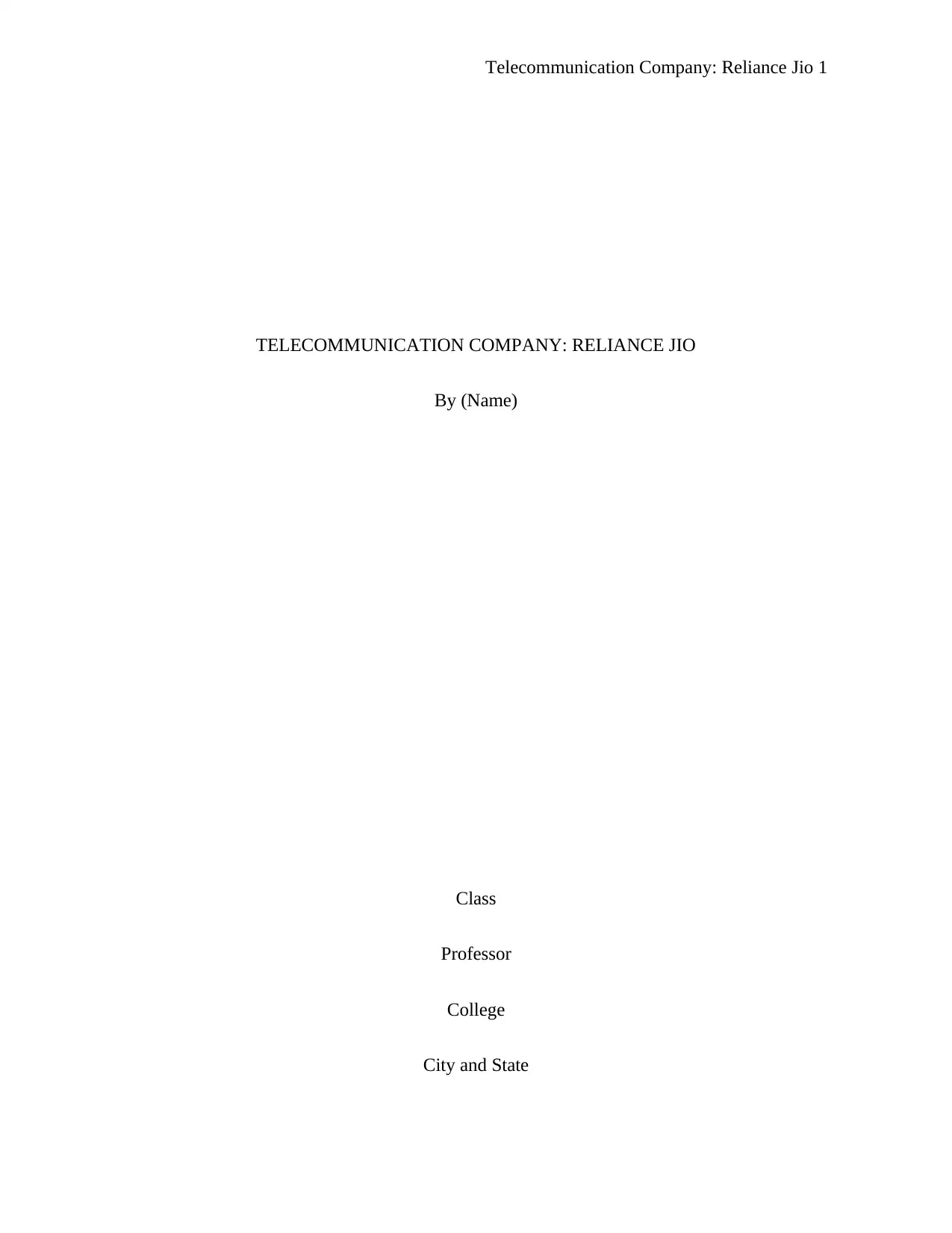
Telecommunication Company: Reliance Jio 1
TELECOMMUNICATION COMPANY: RELIANCE JIO
By (Name)
Class
Professor
College
City and State
TELECOMMUNICATION COMPANY: RELIANCE JIO
By (Name)
Class
Professor
College
City and State
Paraphrase This Document
Need a fresh take? Get an instant paraphrase of this document with our AI Paraphraser
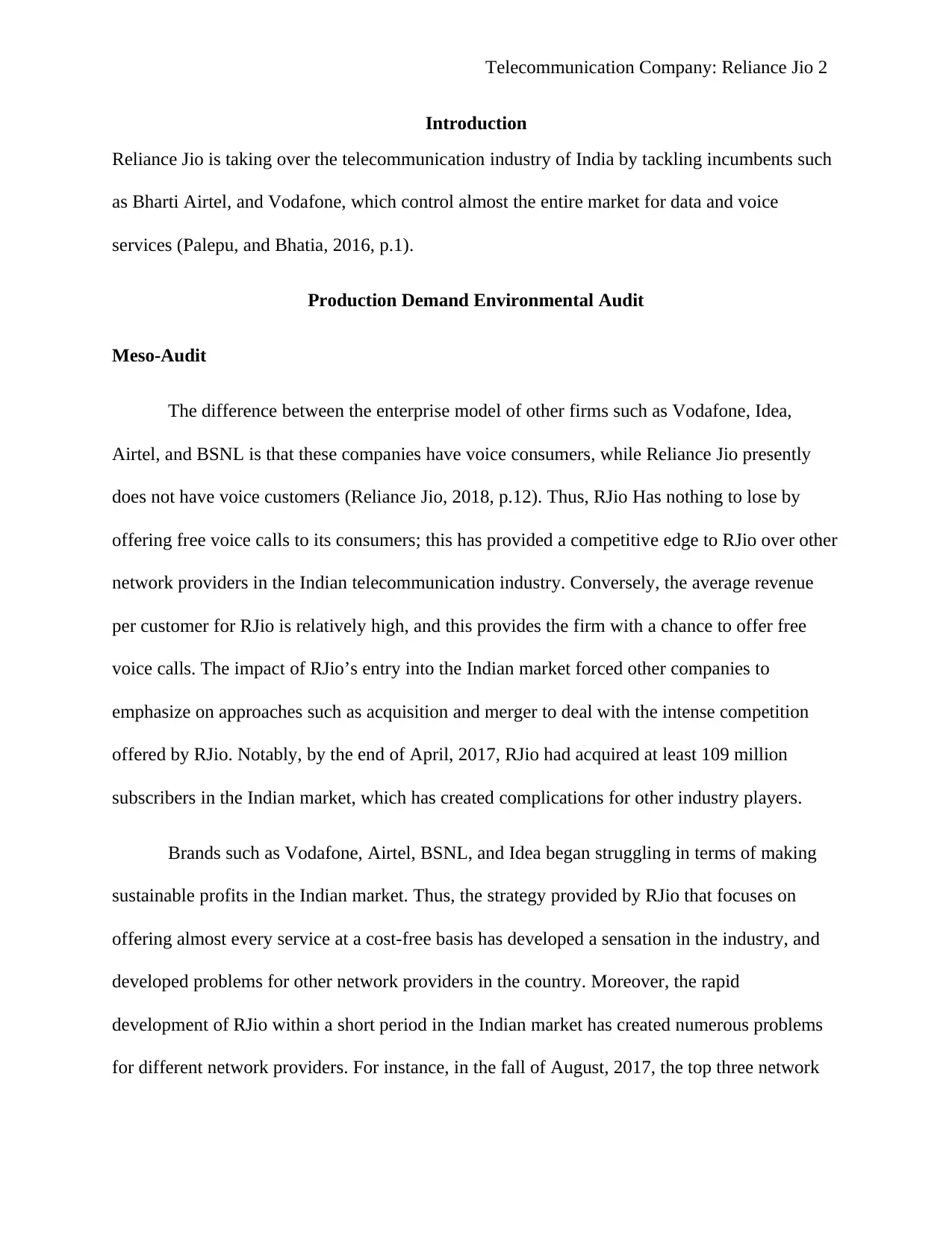
Telecommunication Company: Reliance Jio 2
Introduction
Reliance Jio is taking over the telecommunication industry of India by tackling incumbents such
as Bharti Airtel, and Vodafone, which control almost the entire market for data and voice
services (Palepu, and Bhatia, 2016, p.1).
Production Demand Environmental Audit
Meso-Audit
The difference between the enterprise model of other firms such as Vodafone, Idea,
Airtel, and BSNL is that these companies have voice consumers, while Reliance Jio presently
does not have voice customers (Reliance Jio, 2018, p.12). Thus, RJio Has nothing to lose by
offering free voice calls to its consumers; this has provided a competitive edge to RJio over other
network providers in the Indian telecommunication industry. Conversely, the average revenue
per customer for RJio is relatively high, and this provides the firm with a chance to offer free
voice calls. The impact of RJio’s entry into the Indian market forced other companies to
emphasize on approaches such as acquisition and merger to deal with the intense competition
offered by RJio. Notably, by the end of April, 2017, RJio had acquired at least 109 million
subscribers in the Indian market, which has created complications for other industry players.
Brands such as Vodafone, Airtel, BSNL, and Idea began struggling in terms of making
sustainable profits in the Indian market. Thus, the strategy provided by RJio that focuses on
offering almost every service at a cost-free basis has developed a sensation in the industry, and
developed problems for other network providers in the country. Moreover, the rapid
development of RJio within a short period in the Indian market has created numerous problems
for different network providers. For instance, in the fall of August, 2017, the top three network
Introduction
Reliance Jio is taking over the telecommunication industry of India by tackling incumbents such
as Bharti Airtel, and Vodafone, which control almost the entire market for data and voice
services (Palepu, and Bhatia, 2016, p.1).
Production Demand Environmental Audit
Meso-Audit
The difference between the enterprise model of other firms such as Vodafone, Idea,
Airtel, and BSNL is that these companies have voice consumers, while Reliance Jio presently
does not have voice customers (Reliance Jio, 2018, p.12). Thus, RJio Has nothing to lose by
offering free voice calls to its consumers; this has provided a competitive edge to RJio over other
network providers in the Indian telecommunication industry. Conversely, the average revenue
per customer for RJio is relatively high, and this provides the firm with a chance to offer free
voice calls. The impact of RJio’s entry into the Indian market forced other companies to
emphasize on approaches such as acquisition and merger to deal with the intense competition
offered by RJio. Notably, by the end of April, 2017, RJio had acquired at least 109 million
subscribers in the Indian market, which has created complications for other industry players.
Brands such as Vodafone, Airtel, BSNL, and Idea began struggling in terms of making
sustainable profits in the Indian market. Thus, the strategy provided by RJio that focuses on
offering almost every service at a cost-free basis has developed a sensation in the industry, and
developed problems for other network providers in the country. Moreover, the rapid
development of RJio within a short period in the Indian market has created numerous problems
for different network providers. For instance, in the fall of August, 2017, the top three network
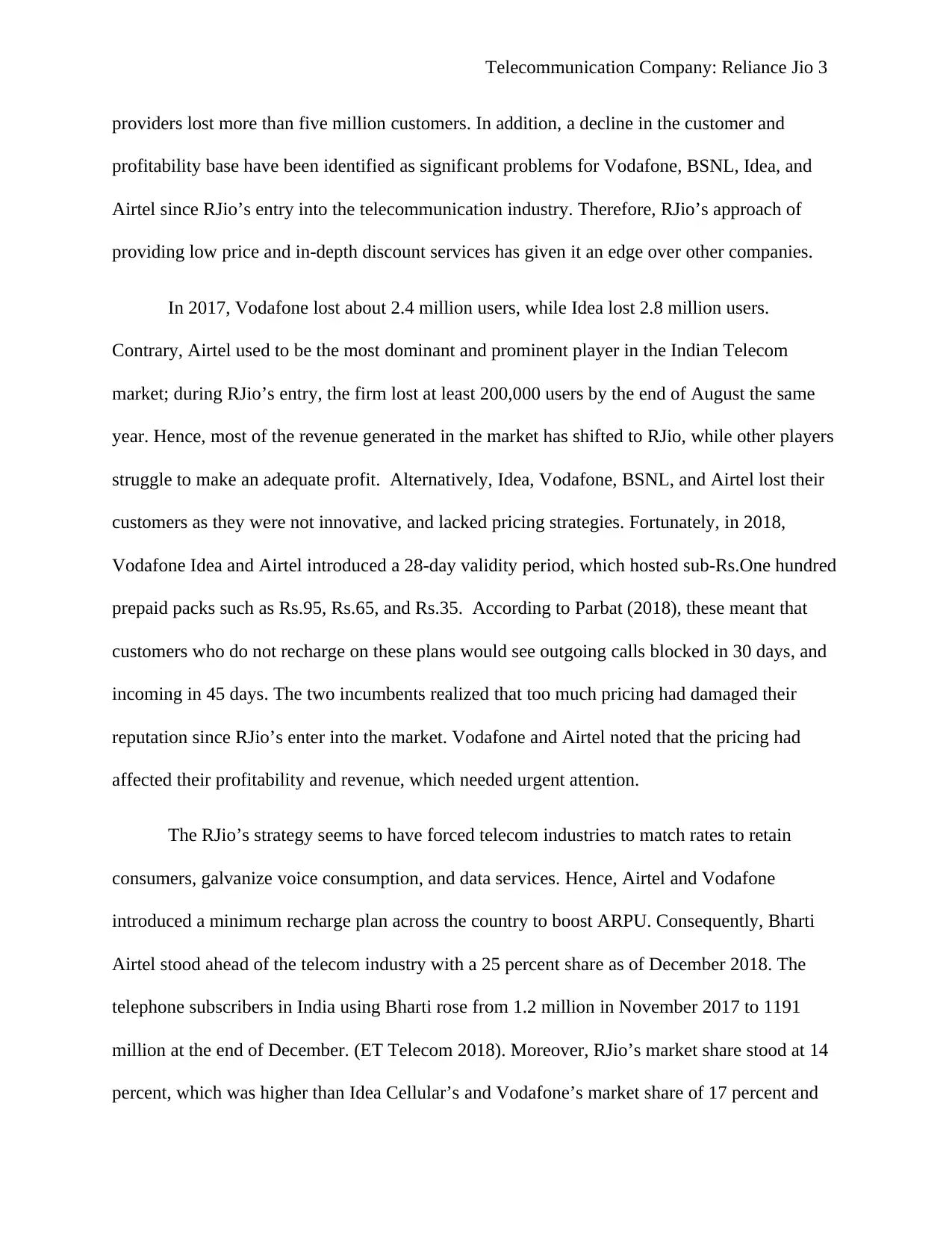
Telecommunication Company: Reliance Jio 3
providers lost more than five million customers. In addition, a decline in the customer and
profitability base have been identified as significant problems for Vodafone, BSNL, Idea, and
Airtel since RJio’s entry into the telecommunication industry. Therefore, RJio’s approach of
providing low price and in-depth discount services has given it an edge over other companies.
In 2017, Vodafone lost about 2.4 million users, while Idea lost 2.8 million users.
Contrary, Airtel used to be the most dominant and prominent player in the Indian Telecom
market; during RJio’s entry, the firm lost at least 200,000 users by the end of August the same
year. Hence, most of the revenue generated in the market has shifted to RJio, while other players
struggle to make an adequate profit. Alternatively, Idea, Vodafone, BSNL, and Airtel lost their
customers as they were not innovative, and lacked pricing strategies. Fortunately, in 2018,
Vodafone Idea and Airtel introduced a 28-day validity period, which hosted sub-Rs.One hundred
prepaid packs such as Rs.95, Rs.65, and Rs.35. According to Parbat (2018), these meant that
customers who do not recharge on these plans would see outgoing calls blocked in 30 days, and
incoming in 45 days. The two incumbents realized that too much pricing had damaged their
reputation since RJio’s enter into the market. Vodafone and Airtel noted that the pricing had
affected their profitability and revenue, which needed urgent attention.
The RJio’s strategy seems to have forced telecom industries to match rates to retain
consumers, galvanize voice consumption, and data services. Hence, Airtel and Vodafone
introduced a minimum recharge plan across the country to boost ARPU. Consequently, Bharti
Airtel stood ahead of the telecom industry with a 25 percent share as of December 2018. The
telephone subscribers in India using Bharti rose from 1.2 million in November 2017 to 1191
million at the end of December. (ET Telecom 2018). Moreover, RJio’s market share stood at 14
percent, which was higher than Idea Cellular’s and Vodafone’s market share of 17 percent and
providers lost more than five million customers. In addition, a decline in the customer and
profitability base have been identified as significant problems for Vodafone, BSNL, Idea, and
Airtel since RJio’s entry into the telecommunication industry. Therefore, RJio’s approach of
providing low price and in-depth discount services has given it an edge over other companies.
In 2017, Vodafone lost about 2.4 million users, while Idea lost 2.8 million users.
Contrary, Airtel used to be the most dominant and prominent player in the Indian Telecom
market; during RJio’s entry, the firm lost at least 200,000 users by the end of August the same
year. Hence, most of the revenue generated in the market has shifted to RJio, while other players
struggle to make an adequate profit. Alternatively, Idea, Vodafone, BSNL, and Airtel lost their
customers as they were not innovative, and lacked pricing strategies. Fortunately, in 2018,
Vodafone Idea and Airtel introduced a 28-day validity period, which hosted sub-Rs.One hundred
prepaid packs such as Rs.95, Rs.65, and Rs.35. According to Parbat (2018), these meant that
customers who do not recharge on these plans would see outgoing calls blocked in 30 days, and
incoming in 45 days. The two incumbents realized that too much pricing had damaged their
reputation since RJio’s enter into the market. Vodafone and Airtel noted that the pricing had
affected their profitability and revenue, which needed urgent attention.
The RJio’s strategy seems to have forced telecom industries to match rates to retain
consumers, galvanize voice consumption, and data services. Hence, Airtel and Vodafone
introduced a minimum recharge plan across the country to boost ARPU. Consequently, Bharti
Airtel stood ahead of the telecom industry with a 25 percent share as of December 2018. The
telephone subscribers in India using Bharti rose from 1.2 million in November 2017 to 1191
million at the end of December. (ET Telecom 2018). Moreover, RJio’s market share stood at 14
percent, which was higher than Idea Cellular’s and Vodafone’s market share of 17 percent and
⊘ This is a preview!⊘
Do you want full access?
Subscribe today to unlock all pages.

Trusted by 1+ million students worldwide
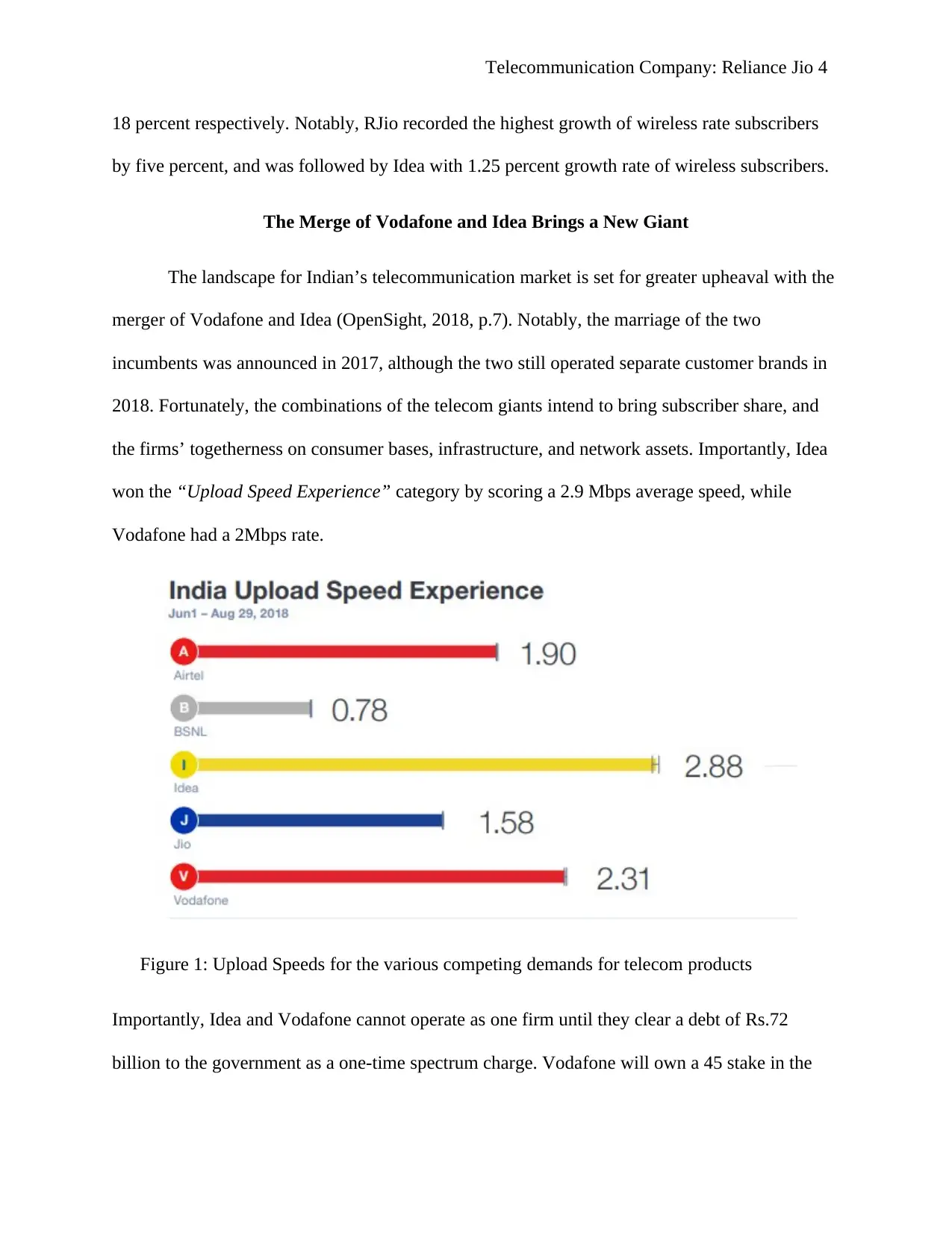
Telecommunication Company: Reliance Jio 4
18 percent respectively. Notably, RJio recorded the highest growth of wireless rate subscribers
by five percent, and was followed by Idea with 1.25 percent growth rate of wireless subscribers.
The Merge of Vodafone and Idea Brings a New Giant
The landscape for Indian’s telecommunication market is set for greater upheaval with the
merger of Vodafone and Idea (OpenSight, 2018, p.7). Notably, the marriage of the two
incumbents was announced in 2017, although the two still operated separate customer brands in
2018. Fortunately, the combinations of the telecom giants intend to bring subscriber share, and
the firms’ togetherness on consumer bases, infrastructure, and network assets. Importantly, Idea
won the “Upload Speed Experience” category by scoring a 2.9 Mbps average speed, while
Vodafone had a 2Mbps rate.
Figure 1: Upload Speeds for the various competing demands for telecom products
Importantly, Idea and Vodafone cannot operate as one firm until they clear a debt of Rs.72
billion to the government as a one-time spectrum charge. Vodafone will own a 45 stake in the
18 percent respectively. Notably, RJio recorded the highest growth of wireless rate subscribers
by five percent, and was followed by Idea with 1.25 percent growth rate of wireless subscribers.
The Merge of Vodafone and Idea Brings a New Giant
The landscape for Indian’s telecommunication market is set for greater upheaval with the
merger of Vodafone and Idea (OpenSight, 2018, p.7). Notably, the marriage of the two
incumbents was announced in 2017, although the two still operated separate customer brands in
2018. Fortunately, the combinations of the telecom giants intend to bring subscriber share, and
the firms’ togetherness on consumer bases, infrastructure, and network assets. Importantly, Idea
won the “Upload Speed Experience” category by scoring a 2.9 Mbps average speed, while
Vodafone had a 2Mbps rate.
Figure 1: Upload Speeds for the various competing demands for telecom products
Importantly, Idea and Vodafone cannot operate as one firm until they clear a debt of Rs.72
billion to the government as a one-time spectrum charge. Vodafone will own a 45 stake in the
Paraphrase This Document
Need a fresh take? Get an instant paraphrase of this document with our AI Paraphraser
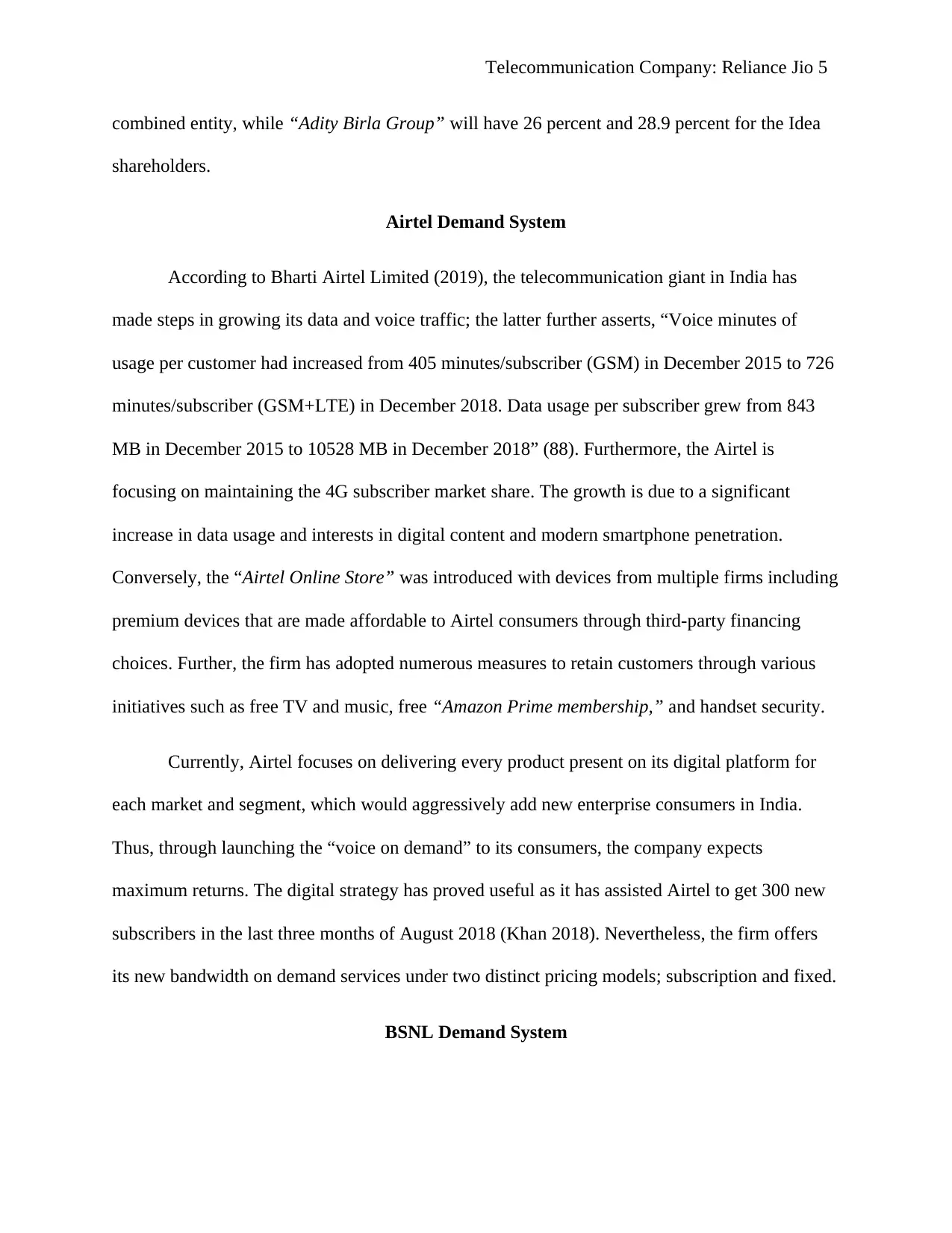
Telecommunication Company: Reliance Jio 5
combined entity, while “Adity Birla Group” will have 26 percent and 28.9 percent for the Idea
shareholders.
Airtel Demand System
According to Bharti Airtel Limited (2019), the telecommunication giant in India has
made steps in growing its data and voice traffic; the latter further asserts, “Voice minutes of
usage per customer had increased from 405 minutes/subscriber (GSM) in December 2015 to 726
minutes/subscriber (GSM+LTE) in December 2018. Data usage per subscriber grew from 843
MB in December 2015 to 10528 MB in December 2018” (88). Furthermore, the Airtel is
focusing on maintaining the 4G subscriber market share. The growth is due to a significant
increase in data usage and interests in digital content and modern smartphone penetration.
Conversely, the “Airtel Online Store” was introduced with devices from multiple firms including
premium devices that are made affordable to Airtel consumers through third-party financing
choices. Further, the firm has adopted numerous measures to retain customers through various
initiatives such as free TV and music, free “Amazon Prime membership,” and handset security.
Currently, Airtel focuses on delivering every product present on its digital platform for
each market and segment, which would aggressively add new enterprise consumers in India.
Thus, through launching the “voice on demand” to its consumers, the company expects
maximum returns. The digital strategy has proved useful as it has assisted Airtel to get 300 new
subscribers in the last three months of August 2018 (Khan 2018). Nevertheless, the firm offers
its new bandwidth on demand services under two distinct pricing models; subscription and fixed.
BSNL Demand System
combined entity, while “Adity Birla Group” will have 26 percent and 28.9 percent for the Idea
shareholders.
Airtel Demand System
According to Bharti Airtel Limited (2019), the telecommunication giant in India has
made steps in growing its data and voice traffic; the latter further asserts, “Voice minutes of
usage per customer had increased from 405 minutes/subscriber (GSM) in December 2015 to 726
minutes/subscriber (GSM+LTE) in December 2018. Data usage per subscriber grew from 843
MB in December 2015 to 10528 MB in December 2018” (88). Furthermore, the Airtel is
focusing on maintaining the 4G subscriber market share. The growth is due to a significant
increase in data usage and interests in digital content and modern smartphone penetration.
Conversely, the “Airtel Online Store” was introduced with devices from multiple firms including
premium devices that are made affordable to Airtel consumers through third-party financing
choices. Further, the firm has adopted numerous measures to retain customers through various
initiatives such as free TV and music, free “Amazon Prime membership,” and handset security.
Currently, Airtel focuses on delivering every product present on its digital platform for
each market and segment, which would aggressively add new enterprise consumers in India.
Thus, through launching the “voice on demand” to its consumers, the company expects
maximum returns. The digital strategy has proved useful as it has assisted Airtel to get 300 new
subscribers in the last three months of August 2018 (Khan 2018). Nevertheless, the firm offers
its new bandwidth on demand services under two distinct pricing models; subscription and fixed.
BSNL Demand System
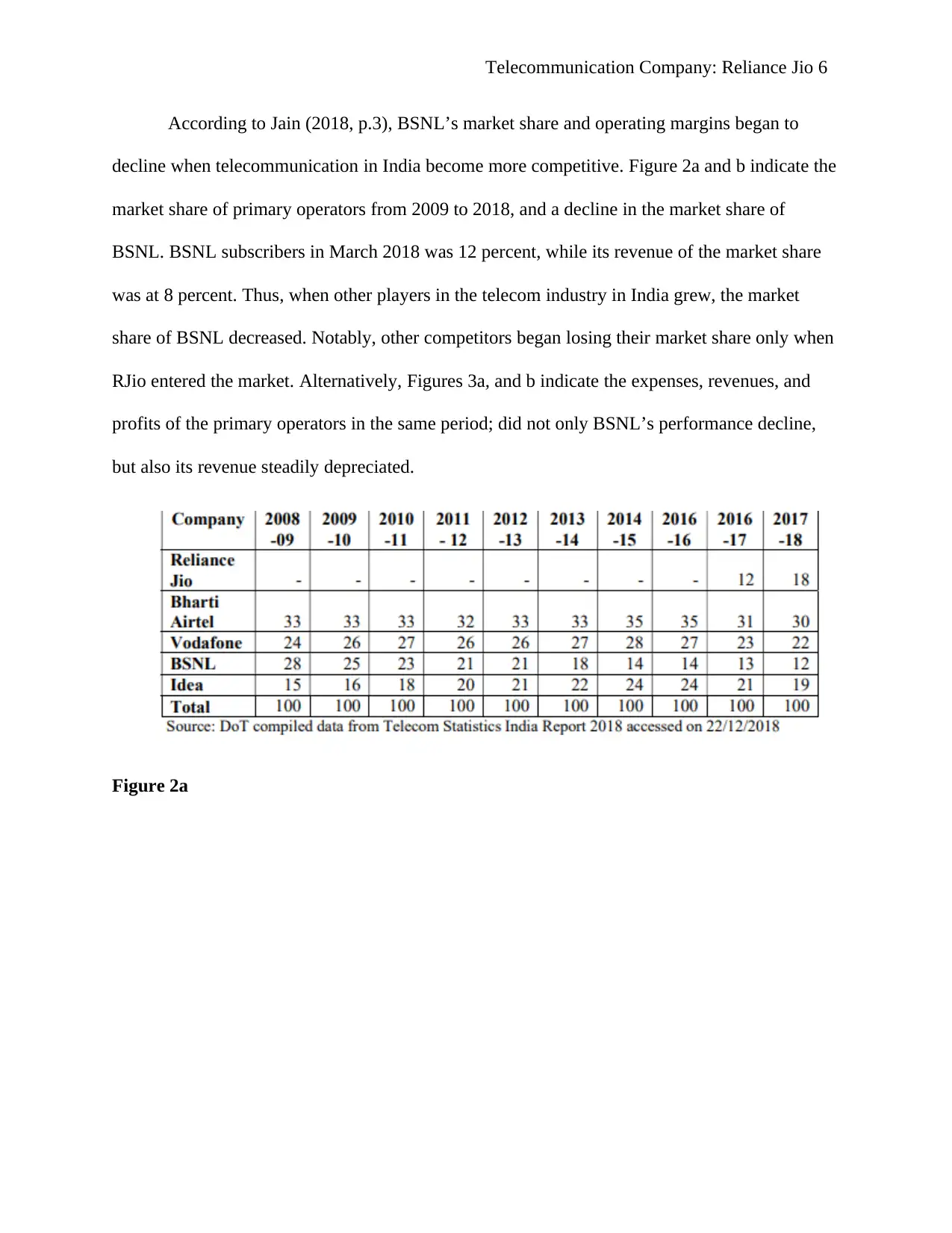
Telecommunication Company: Reliance Jio 6
According to Jain (2018, p.3), BSNL’s market share and operating margins began to
decline when telecommunication in India become more competitive. Figure 2a and b indicate the
market share of primary operators from 2009 to 2018, and a decline in the market share of
BSNL. BSNL subscribers in March 2018 was 12 percent, while its revenue of the market share
was at 8 percent. Thus, when other players in the telecom industry in India grew, the market
share of BSNL decreased. Notably, other competitors began losing their market share only when
RJio entered the market. Alternatively, Figures 3a, and b indicate the expenses, revenues, and
profits of the primary operators in the same period; did not only BSNL’s performance decline,
but also its revenue steadily depreciated.
Figure 2a
According to Jain (2018, p.3), BSNL’s market share and operating margins began to
decline when telecommunication in India become more competitive. Figure 2a and b indicate the
market share of primary operators from 2009 to 2018, and a decline in the market share of
BSNL. BSNL subscribers in March 2018 was 12 percent, while its revenue of the market share
was at 8 percent. Thus, when other players in the telecom industry in India grew, the market
share of BSNL decreased. Notably, other competitors began losing their market share only when
RJio entered the market. Alternatively, Figures 3a, and b indicate the expenses, revenues, and
profits of the primary operators in the same period; did not only BSNL’s performance decline,
but also its revenue steadily depreciated.
Figure 2a
⊘ This is a preview!⊘
Do you want full access?
Subscribe today to unlock all pages.

Trusted by 1+ million students worldwide
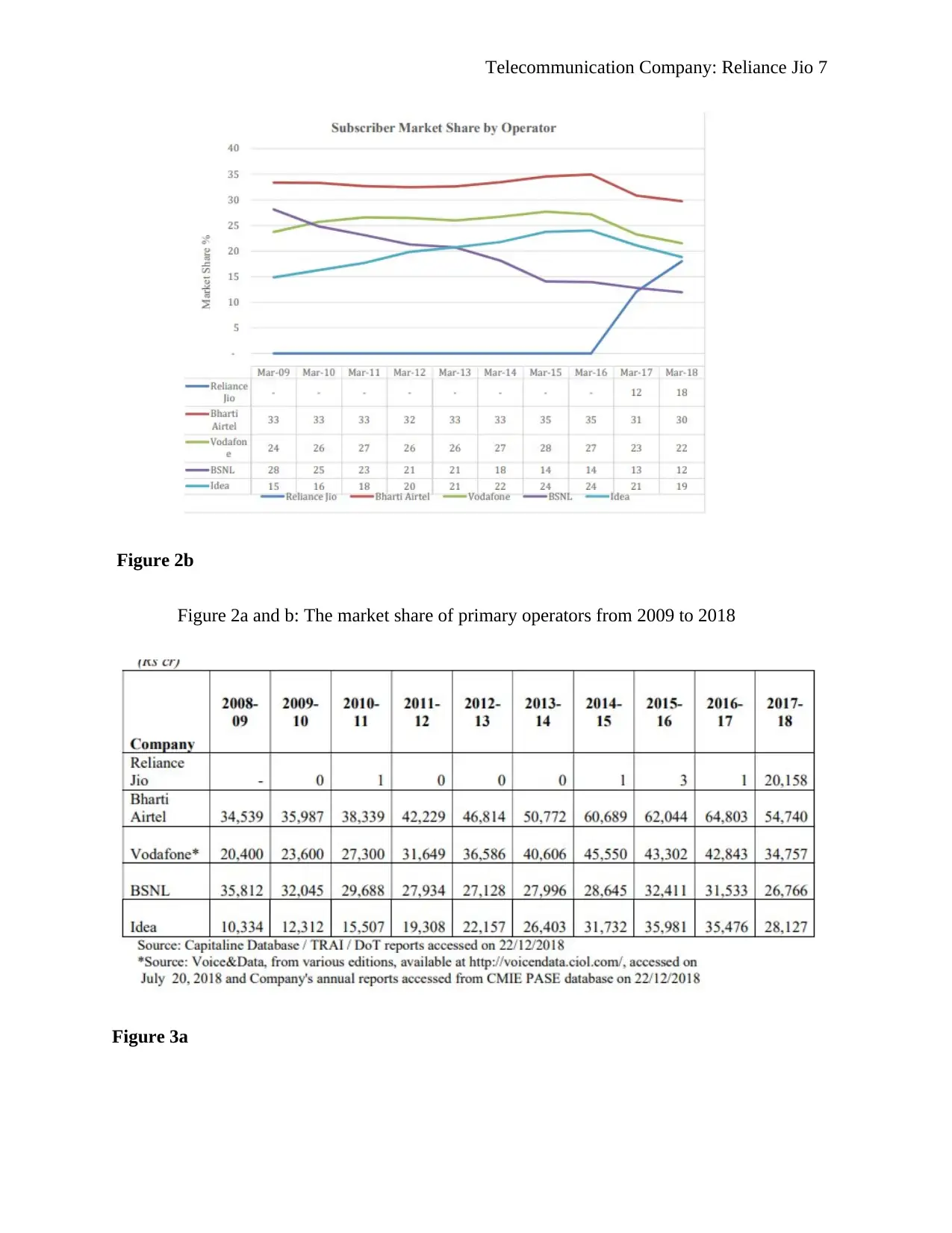
Telecommunication Company: Reliance Jio 7
Figure 2b
Figure 2a and b: The market share of primary operators from 2009 to 2018
Figure 3a
Figure 2b
Figure 2a and b: The market share of primary operators from 2009 to 2018
Figure 3a
Paraphrase This Document
Need a fresh take? Get an instant paraphrase of this document with our AI Paraphraser
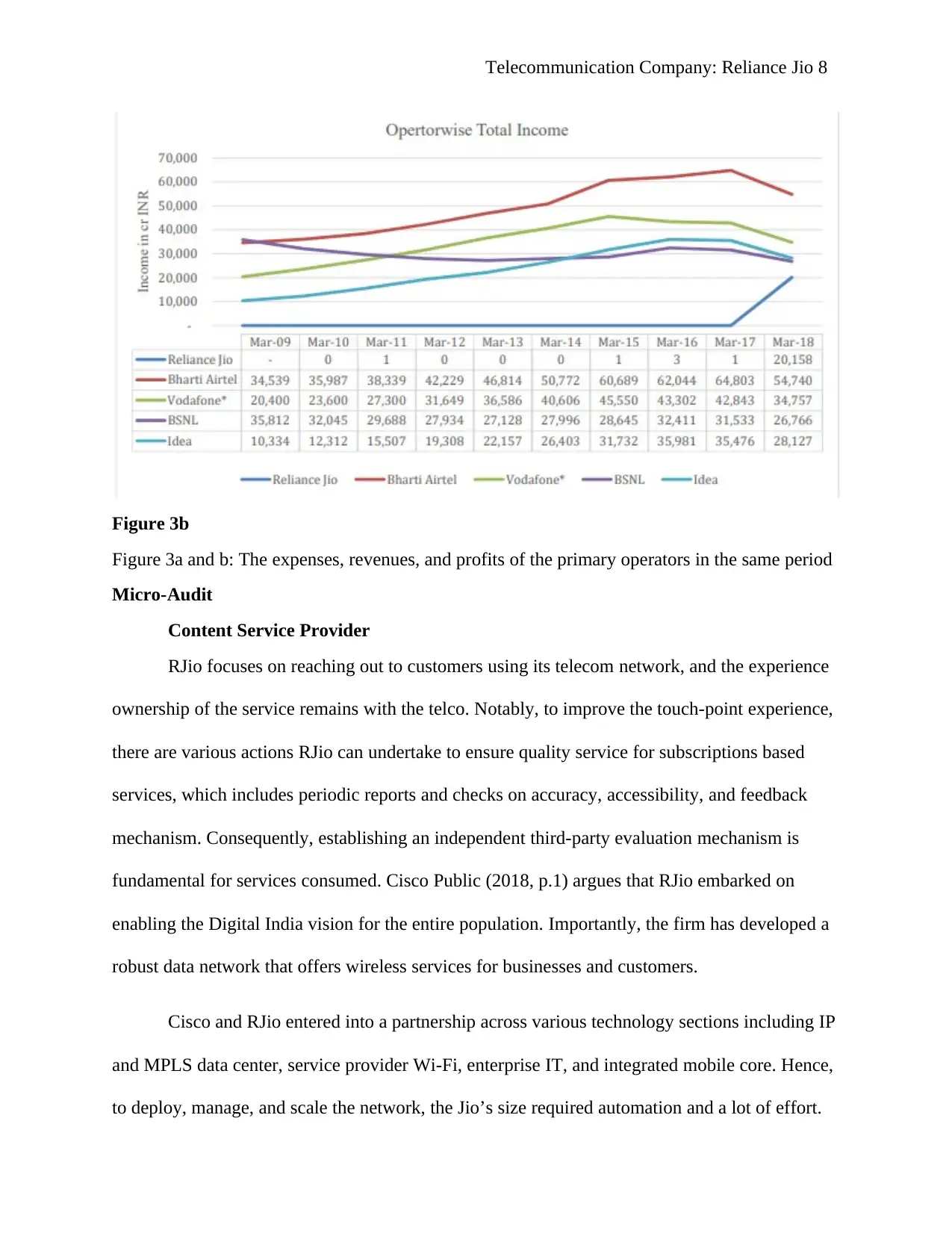
Telecommunication Company: Reliance Jio 8
Figure 3b
Figure 3a and b: The expenses, revenues, and profits of the primary operators in the same period
Micro-Audit
Content Service Provider
RJio focuses on reaching out to customers using its telecom network, and the experience
ownership of the service remains with the telco. Notably, to improve the touch-point experience,
there are various actions RJio can undertake to ensure quality service for subscriptions based
services, which includes periodic reports and checks on accuracy, accessibility, and feedback
mechanism. Consequently, establishing an independent third-party evaluation mechanism is
fundamental for services consumed. Cisco Public (2018, p.1) argues that RJio embarked on
enabling the Digital India vision for the entire population. Importantly, the firm has developed a
robust data network that offers wireless services for businesses and customers.
Cisco and RJio entered into a partnership across various technology sections including IP
and MPLS data center, service provider Wi-Fi, enterprise IT, and integrated mobile core. Hence,
to deploy, manage, and scale the network, the Jio’s size required automation and a lot of effort.
Figure 3b
Figure 3a and b: The expenses, revenues, and profits of the primary operators in the same period
Micro-Audit
Content Service Provider
RJio focuses on reaching out to customers using its telecom network, and the experience
ownership of the service remains with the telco. Notably, to improve the touch-point experience,
there are various actions RJio can undertake to ensure quality service for subscriptions based
services, which includes periodic reports and checks on accuracy, accessibility, and feedback
mechanism. Consequently, establishing an independent third-party evaluation mechanism is
fundamental for services consumed. Cisco Public (2018, p.1) argues that RJio embarked on
enabling the Digital India vision for the entire population. Importantly, the firm has developed a
robust data network that offers wireless services for businesses and customers.
Cisco and RJio entered into a partnership across various technology sections including IP
and MPLS data center, service provider Wi-Fi, enterprise IT, and integrated mobile core. Hence,
to deploy, manage, and scale the network, the Jio’s size required automation and a lot of effort.
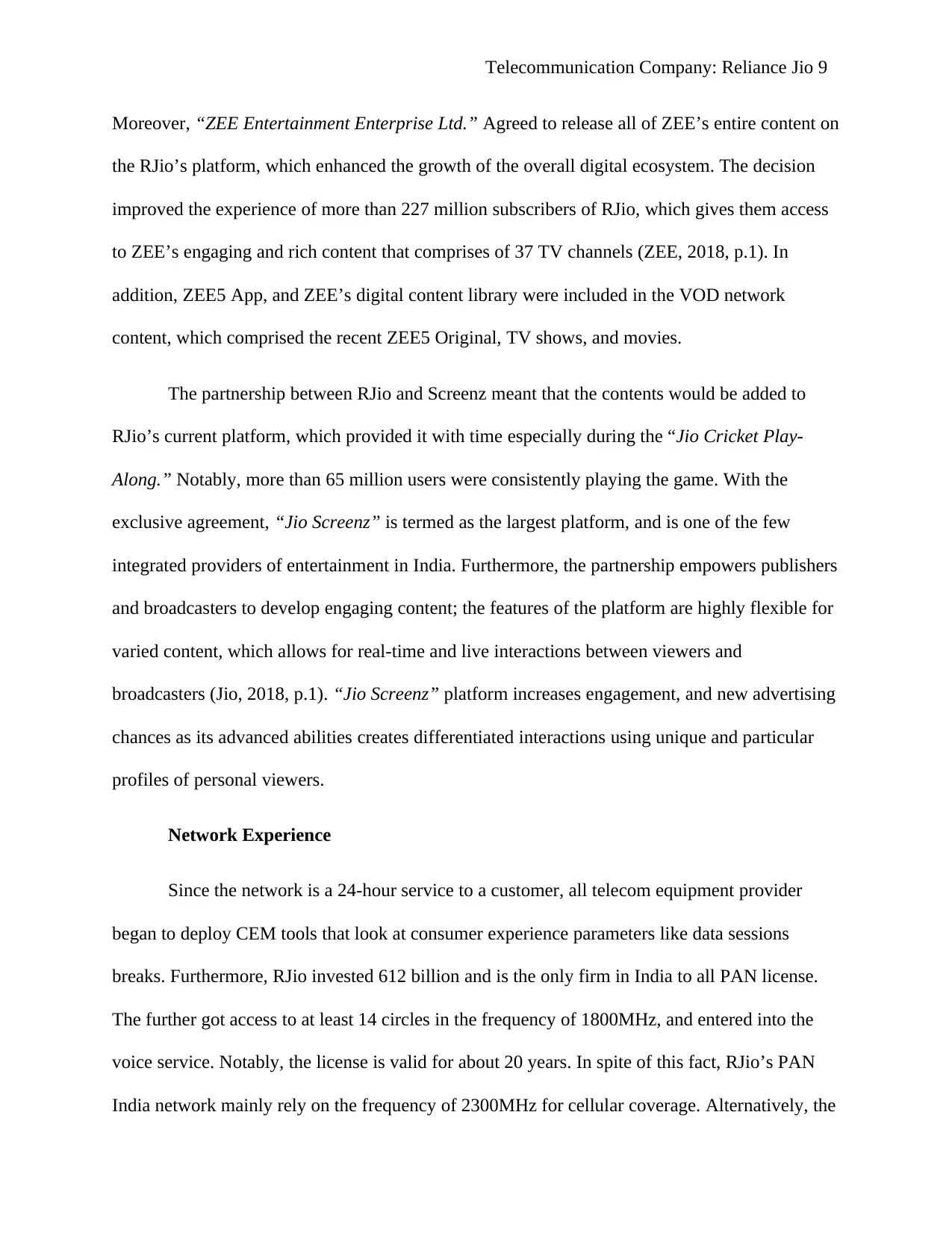
Telecommunication Company: Reliance Jio 9
Moreover, “ZEE Entertainment Enterprise Ltd.” Agreed to release all of ZEE’s entire content on
the RJio’s platform, which enhanced the growth of the overall digital ecosystem. The decision
improved the experience of more than 227 million subscribers of RJio, which gives them access
to ZEE’s engaging and rich content that comprises of 37 TV channels (ZEE, 2018, p.1). In
addition, ZEE5 App, and ZEE’s digital content library were included in the VOD network
content, which comprised the recent ZEE5 Original, TV shows, and movies.
The partnership between RJio and Screenz meant that the contents would be added to
RJio’s current platform, which provided it with time especially during the “Jio Cricket Play-
Along.” Notably, more than 65 million users were consistently playing the game. With the
exclusive agreement, “Jio Screenz” is termed as the largest platform, and is one of the few
integrated providers of entertainment in India. Furthermore, the partnership empowers publishers
and broadcasters to develop engaging content; the features of the platform are highly flexible for
varied content, which allows for real-time and live interactions between viewers and
broadcasters (Jio, 2018, p.1). “Jio Screenz” platform increases engagement, and new advertising
chances as its advanced abilities creates differentiated interactions using unique and particular
profiles of personal viewers.
Network Experience
Since the network is a 24-hour service to a customer, all telecom equipment provider
began to deploy CEM tools that look at consumer experience parameters like data sessions
breaks. Furthermore, RJio invested 612 billion and is the only firm in India to all PAN license.
The further got access to at least 14 circles in the frequency of 1800MHz, and entered into the
voice service. Notably, the license is valid for about 20 years. In spite of this fact, RJio’s PAN
India network mainly rely on the frequency of 2300MHz for cellular coverage. Alternatively, the
Moreover, “ZEE Entertainment Enterprise Ltd.” Agreed to release all of ZEE’s entire content on
the RJio’s platform, which enhanced the growth of the overall digital ecosystem. The decision
improved the experience of more than 227 million subscribers of RJio, which gives them access
to ZEE’s engaging and rich content that comprises of 37 TV channels (ZEE, 2018, p.1). In
addition, ZEE5 App, and ZEE’s digital content library were included in the VOD network
content, which comprised the recent ZEE5 Original, TV shows, and movies.
The partnership between RJio and Screenz meant that the contents would be added to
RJio’s current platform, which provided it with time especially during the “Jio Cricket Play-
Along.” Notably, more than 65 million users were consistently playing the game. With the
exclusive agreement, “Jio Screenz” is termed as the largest platform, and is one of the few
integrated providers of entertainment in India. Furthermore, the partnership empowers publishers
and broadcasters to develop engaging content; the features of the platform are highly flexible for
varied content, which allows for real-time and live interactions between viewers and
broadcasters (Jio, 2018, p.1). “Jio Screenz” platform increases engagement, and new advertising
chances as its advanced abilities creates differentiated interactions using unique and particular
profiles of personal viewers.
Network Experience
Since the network is a 24-hour service to a customer, all telecom equipment provider
began to deploy CEM tools that look at consumer experience parameters like data sessions
breaks. Furthermore, RJio invested 612 billion and is the only firm in India to all PAN license.
The further got access to at least 14 circles in the frequency of 1800MHz, and entered into the
voice service. Notably, the license is valid for about 20 years. In spite of this fact, RJio’s PAN
India network mainly rely on the frequency of 2300MHz for cellular coverage. Alternatively, the
⊘ This is a preview!⊘
Do you want full access?
Subscribe today to unlock all pages.

Trusted by 1+ million students worldwide
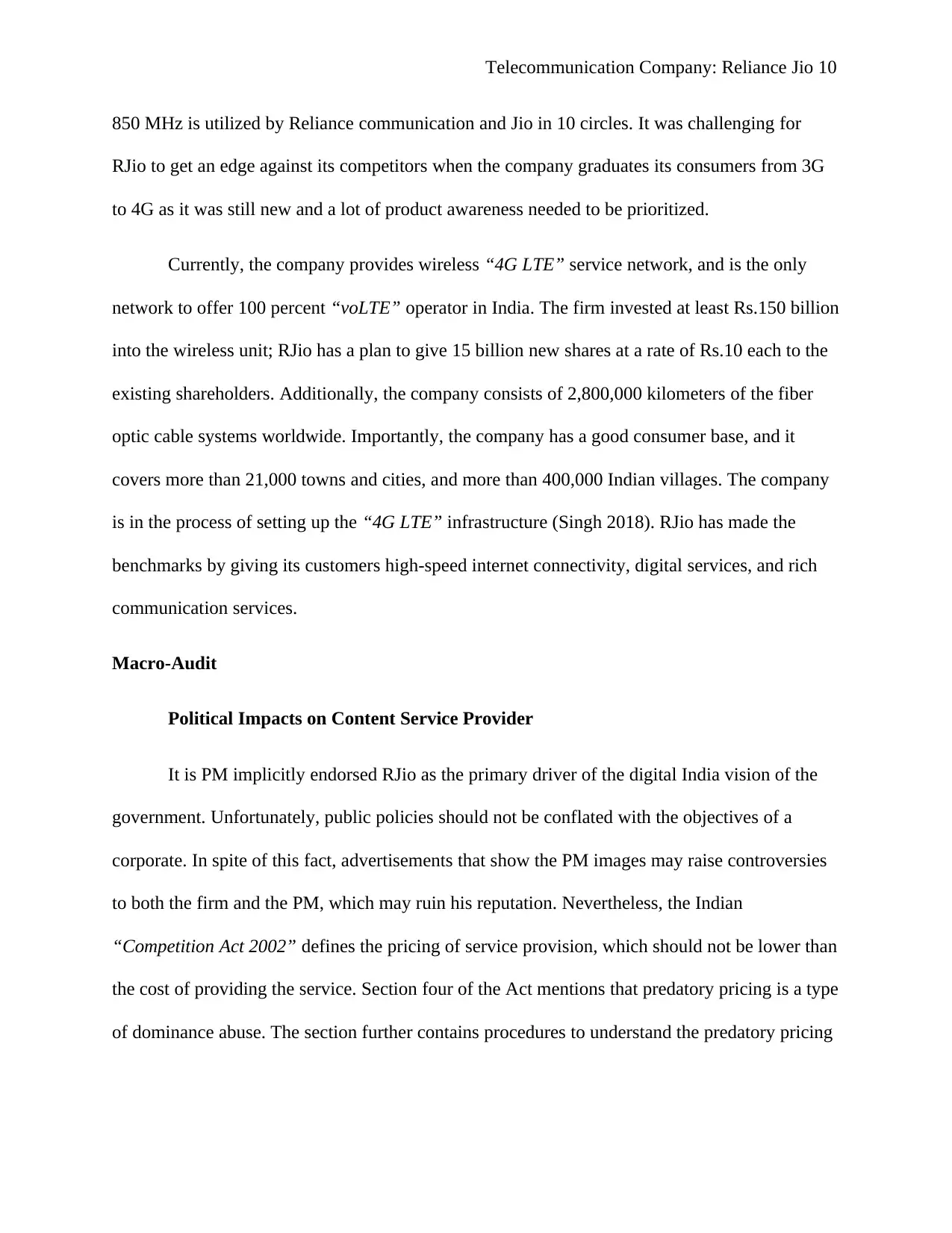
Telecommunication Company: Reliance Jio 10
850 MHz is utilized by Reliance communication and Jio in 10 circles. It was challenging for
RJio to get an edge against its competitors when the company graduates its consumers from 3G
to 4G as it was still new and a lot of product awareness needed to be prioritized.
Currently, the company provides wireless “4G LTE” service network, and is the only
network to offer 100 percent “voLTE” operator in India. The firm invested at least Rs.150 billion
into the wireless unit; RJio has a plan to give 15 billion new shares at a rate of Rs.10 each to the
existing shareholders. Additionally, the company consists of 2,800,000 kilometers of the fiber
optic cable systems worldwide. Importantly, the company has a good consumer base, and it
covers more than 21,000 towns and cities, and more than 400,000 Indian villages. The company
is in the process of setting up the “4G LTE” infrastructure (Singh 2018). RJio has made the
benchmarks by giving its customers high-speed internet connectivity, digital services, and rich
communication services.
Macro-Audit
Political Impacts on Content Service Provider
It is PM implicitly endorsed RJio as the primary driver of the digital India vision of the
government. Unfortunately, public policies should not be conflated with the objectives of a
corporate. In spite of this fact, advertisements that show the PM images may raise controversies
to both the firm and the PM, which may ruin his reputation. Nevertheless, the Indian
“Competition Act 2002” defines the pricing of service provision, which should not be lower than
the cost of providing the service. Section four of the Act mentions that predatory pricing is a type
of dominance abuse. The section further contains procedures to understand the predatory pricing
850 MHz is utilized by Reliance communication and Jio in 10 circles. It was challenging for
RJio to get an edge against its competitors when the company graduates its consumers from 3G
to 4G as it was still new and a lot of product awareness needed to be prioritized.
Currently, the company provides wireless “4G LTE” service network, and is the only
network to offer 100 percent “voLTE” operator in India. The firm invested at least Rs.150 billion
into the wireless unit; RJio has a plan to give 15 billion new shares at a rate of Rs.10 each to the
existing shareholders. Additionally, the company consists of 2,800,000 kilometers of the fiber
optic cable systems worldwide. Importantly, the company has a good consumer base, and it
covers more than 21,000 towns and cities, and more than 400,000 Indian villages. The company
is in the process of setting up the “4G LTE” infrastructure (Singh 2018). RJio has made the
benchmarks by giving its customers high-speed internet connectivity, digital services, and rich
communication services.
Macro-Audit
Political Impacts on Content Service Provider
It is PM implicitly endorsed RJio as the primary driver of the digital India vision of the
government. Unfortunately, public policies should not be conflated with the objectives of a
corporate. In spite of this fact, advertisements that show the PM images may raise controversies
to both the firm and the PM, which may ruin his reputation. Nevertheless, the Indian
“Competition Act 2002” defines the pricing of service provision, which should not be lower than
the cost of providing the service. Section four of the Act mentions that predatory pricing is a type
of dominance abuse. The section further contains procedures to understand the predatory pricing
Paraphrase This Document
Need a fresh take? Get an instant paraphrase of this document with our AI Paraphraser
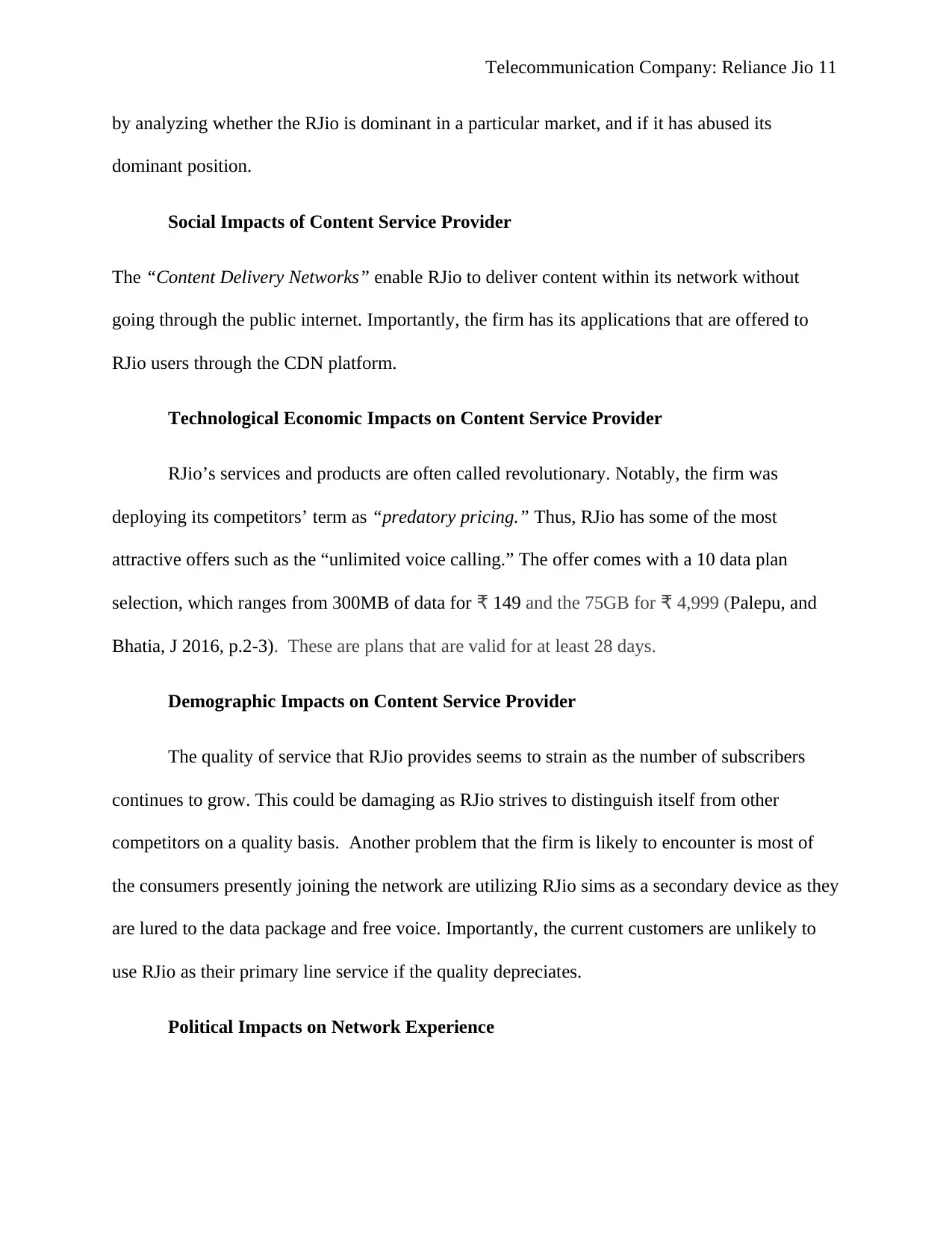
Telecommunication Company: Reliance Jio 11
by analyzing whether the RJio is dominant in a particular market, and if it has abused its
dominant position.
Social Impacts of Content Service Provider
The “Content Delivery Networks” enable RJio to deliver content within its network without
going through the public internet. Importantly, the firm has its applications that are offered to
RJio users through the CDN platform.
Technological Economic Impacts on Content Service Provider
RJio’s services and products are often called revolutionary. Notably, the firm was
deploying its competitors’ term as “predatory pricing.” Thus, RJio has some of the most
attractive offers such as the “unlimited voice calling.” The offer comes with a 10 data plan
selection, which ranges from 300MB of data for ₹ 149 and the 75GB for ₹ 4,999 (Palepu, and
Bhatia, J 2016, p.2-3). These are plans that are valid for at least 28 days.
Demographic Impacts on Content Service Provider
The quality of service that RJio provides seems to strain as the number of subscribers
continues to grow. This could be damaging as RJio strives to distinguish itself from other
competitors on a quality basis. Another problem that the firm is likely to encounter is most of
the consumers presently joining the network are utilizing RJio sims as a secondary device as they
are lured to the data package and free voice. Importantly, the current customers are unlikely to
use RJio as their primary line service if the quality depreciates.
Political Impacts on Network Experience
by analyzing whether the RJio is dominant in a particular market, and if it has abused its
dominant position.
Social Impacts of Content Service Provider
The “Content Delivery Networks” enable RJio to deliver content within its network without
going through the public internet. Importantly, the firm has its applications that are offered to
RJio users through the CDN platform.
Technological Economic Impacts on Content Service Provider
RJio’s services and products are often called revolutionary. Notably, the firm was
deploying its competitors’ term as “predatory pricing.” Thus, RJio has some of the most
attractive offers such as the “unlimited voice calling.” The offer comes with a 10 data plan
selection, which ranges from 300MB of data for ₹ 149 and the 75GB for ₹ 4,999 (Palepu, and
Bhatia, J 2016, p.2-3). These are plans that are valid for at least 28 days.
Demographic Impacts on Content Service Provider
The quality of service that RJio provides seems to strain as the number of subscribers
continues to grow. This could be damaging as RJio strives to distinguish itself from other
competitors on a quality basis. Another problem that the firm is likely to encounter is most of
the consumers presently joining the network are utilizing RJio sims as a secondary device as they
are lured to the data package and free voice. Importantly, the current customers are unlikely to
use RJio as their primary line service if the quality depreciates.
Political Impacts on Network Experience
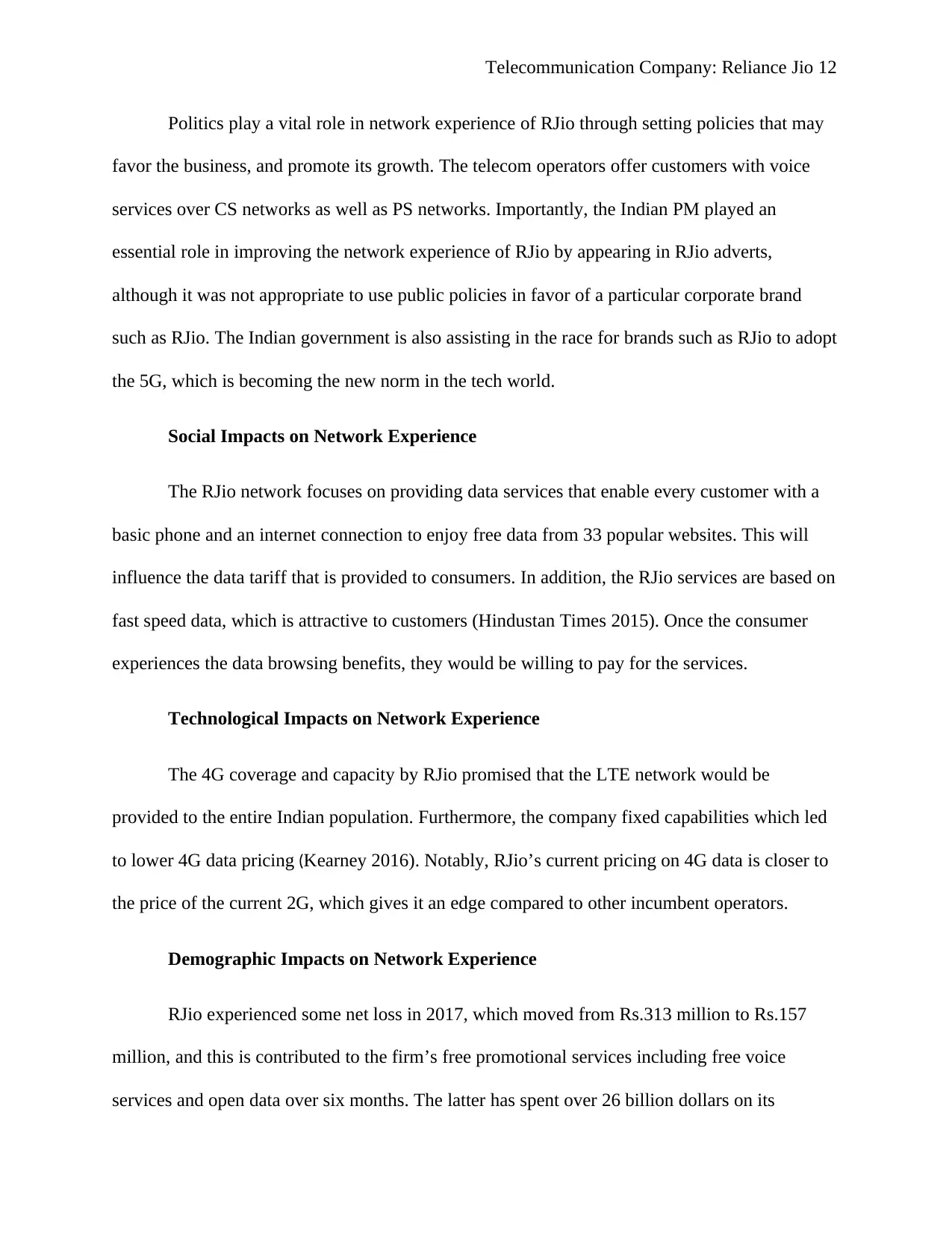
Telecommunication Company: Reliance Jio 12
Politics play a vital role in network experience of RJio through setting policies that may
favor the business, and promote its growth. The telecom operators offer customers with voice
services over CS networks as well as PS networks. Importantly, the Indian PM played an
essential role in improving the network experience of RJio by appearing in RJio adverts,
although it was not appropriate to use public policies in favor of a particular corporate brand
such as RJio. The Indian government is also assisting in the race for brands such as RJio to adopt
the 5G, which is becoming the new norm in the tech world.
Social Impacts on Network Experience
The RJio network focuses on providing data services that enable every customer with a
basic phone and an internet connection to enjoy free data from 33 popular websites. This will
influence the data tariff that is provided to consumers. In addition, the RJio services are based on
fast speed data, which is attractive to customers (Hindustan Times 2015). Once the consumer
experiences the data browsing benefits, they would be willing to pay for the services.
Technological Impacts on Network Experience
The 4G coverage and capacity by RJio promised that the LTE network would be
provided to the entire Indian population. Furthermore, the company fixed capabilities which led
to lower 4G data pricing (Kearney 2016). Notably, RJio’s current pricing on 4G data is closer to
the price of the current 2G, which gives it an edge compared to other incumbent operators.
Demographic Impacts on Network Experience
RJio experienced some net loss in 2017, which moved from Rs.313 million to Rs.157
million, and this is contributed to the firm’s free promotional services including free voice
services and open data over six months. The latter has spent over 26 billion dollars on its
Politics play a vital role in network experience of RJio through setting policies that may
favor the business, and promote its growth. The telecom operators offer customers with voice
services over CS networks as well as PS networks. Importantly, the Indian PM played an
essential role in improving the network experience of RJio by appearing in RJio adverts,
although it was not appropriate to use public policies in favor of a particular corporate brand
such as RJio. The Indian government is also assisting in the race for brands such as RJio to adopt
the 5G, which is becoming the new norm in the tech world.
Social Impacts on Network Experience
The RJio network focuses on providing data services that enable every customer with a
basic phone and an internet connection to enjoy free data from 33 popular websites. This will
influence the data tariff that is provided to consumers. In addition, the RJio services are based on
fast speed data, which is attractive to customers (Hindustan Times 2015). Once the consumer
experiences the data browsing benefits, they would be willing to pay for the services.
Technological Impacts on Network Experience
The 4G coverage and capacity by RJio promised that the LTE network would be
provided to the entire Indian population. Furthermore, the company fixed capabilities which led
to lower 4G data pricing (Kearney 2016). Notably, RJio’s current pricing on 4G data is closer to
the price of the current 2G, which gives it an edge compared to other incumbent operators.
Demographic Impacts on Network Experience
RJio experienced some net loss in 2017, which moved from Rs.313 million to Rs.157
million, and this is contributed to the firm’s free promotional services including free voice
services and open data over six months. The latter has spent over 26 billion dollars on its
⊘ This is a preview!⊘
Do you want full access?
Subscribe today to unlock all pages.

Trusted by 1+ million students worldwide
1 out of 17
Related Documents
Your All-in-One AI-Powered Toolkit for Academic Success.
+13062052269
info@desklib.com
Available 24*7 on WhatsApp / Email
![[object Object]](/_next/static/media/star-bottom.7253800d.svg)
Unlock your academic potential
Copyright © 2020–2025 A2Z Services. All Rights Reserved. Developed and managed by ZUCOL.





